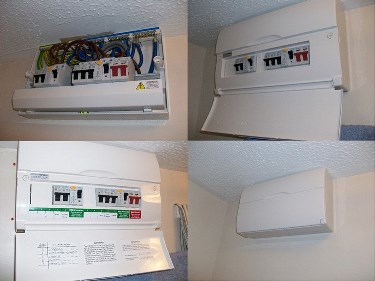There is a legal requirement that certain electrical works carried out in domestic properties have to be registered with Local Authorities. The Building Regulations apply to every householder having work carried out in their home or properties. As the householder it is your responsibility to ensure that work carried out complies with the current Building Regulations. If you do not comply, the work will not be legal and you may be held accountable. If a registered Competent Person, such as company registered with NICEIC, is employed to carry out the work, then the responsibility is transferred to the Competent Person.
I can help and will ensure that the Building Regulations and Wiring Regulations are complied with, inspect, test and certify the installation and then register the work with your Local Authority through the NICEIC.
- New lighting circuits

- Extensions to existing circuits, such as added plug sockets
- Outdoor sockets/lights
- Old fuse board to new consumer unit upgrades
- Repairs to circuits, fittings and electrical points
- Maintenance of electrical circuitry
- All form of electrical repairs
- Fault finding & testing
Call now on 07800 844349 and you will be in safe hands.
What is a ‘consumer unit’ & why should I replace my old ‘fuse box’?
A ‘Consumer Unit’ feeds electricity to all of the circuits in your home. You may know it as a ‘Fuse Box’ or ‘Distribution Board. Older types of Fuse Boxes contain pull out fuses where you had to replace the fuse wire when they burnt out. A typical old style Fuse Box will look similar to one of these:

Modern Consumer Units are fitted with ‘Miniature Circuit Breakers’ (Trip Switches). This fairly new technology means that you can simply reset the circuit breaker if it trips, as long as there is no fault on the circuit. You can also isolate one circuit at a time without interrupting other circuits.
They also contain RCD’s (Residual Current Device’s). An RCD disconnects the power whenever it detects that the electric current is not balanced, if there is a short circuit or safety issue, for example. A cause of this could be if you drill through, or accidentally cut through cables. An RCD will trip in Milliseconds rather than seconds (with an old fuse box), which can mean the difference between life and death if someone is electrocuted in these circumstances.
A modern Consumer Unit will look similar to this:

Why Should I Upgrade To A Consumer Unit?
The most obvious reason is safety. As well as providing overload protection, the built in RCD means that the electricity will be disconnected within a fraction of a second if a fault is detected. This means you and your family are safer in your home and protected against electric shock in the event of a fault.
You might have heard stories from friends or family who have an RCD that it trips the house out whenever a light bulb blows. Consumer Units generally have two RCD’s. The way Odyssey install Consumer Unit’s means that if one RCD trips due to a fault, the other will remain on. In simple terms, we split the circuits so that if your downstairs lights go out, most of the house will still have power.
